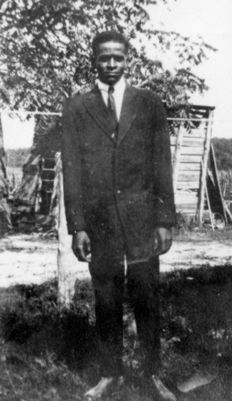November 11–18, 1999
cover story
A Journey to Springtown, part 2
The all-but-forgotten New Jersey village that changed African-American history — and the Philadelphia woman helping to bring its story to the world.
Into Springtown
At first glance, it is hard to see the merit in a small village that looks like any other town in southwest New Jersey’s tide country.
A rural road with a 50-mph speed limit runs through the middle of it. On the right side, coming from Greenwich, lies the Bethel A.M.E. Church. Just down the road from it is an abandoned ballfield. Small, nondescript ranch houses and several late 19th-century houses, some not wearing their age too well, are scattered around the church. A few old cemeteries can be found in the woods nearby.
Laura parks her car alongside the church, which was built in Springtown in 1838 to replace the Othello A.M.E. Church destroyed by arson. It’s now called Bethel because of its association with the Mother Bethel A.M.E. Church in Philadelphia, the great church founded by Richard Allen, who came to western New Jersey to preach to the blacks of Cumberland County in 1780.
Bethel has never been damaged in its 160-plus years of existence. It’s a small building, its interior measuring only 25 feet across. Yet during its heyday, its stature in the community was great. Like every A.M.E. church, it was a station on the Underground Railroad. Early African-American men learned the fine points of rhetoric within its walls. It was a meeting place for the community, and a hiding place.
"My memories of Springtown were not that great," says Aldrich. "Because I didn’t know the significance of the town and what had transpired there, and why my mother was dragging us down to that church. She never told us the reason why. But to me it was just an out-of-the-way, country place."
Then, in 1994, after a 40-year absence from this town that she had dismissed, Laura returned one Sunday for service.
Why the sudden homecoming?
"I finally knew what it meant," she says. The lesson her mother had been trying to teach her was that the church had been a beacon of hope to former slaves. They had huddled inside on cold night when the bounty hunters were prowling the field and woods. This building had saved lives. It had protected hundreds. Five years of research had helped her understand what she had once been too young to comprehend.
"This church should’ve fallen," says Laura. "But it didn’t."
Indeed, by the early 1990s, the church had become infested with termites. The local bishop — Bishop Phillip Cousin — considered closing it down. That was when Laura took on the next phase of her project. What started as a genealogy project became a revitalization program. She gathered members of the Bethel congregation, including Bunny Robinson, and formed the Othello Restoration Project (ORC), whose purpose was to restore the church.
|
Restoration
During the first years of the project, there were obstacles.
Bishop Cousin didn’t quite know what to make of this interloper from Philadelphia, Laura suspects. Many of the congregants were more interested in building a new church than saving an old one. And those congregants who were interested didn’t have the means to help provide the necessary funding.
Laura, though, is strong-willed, a force of nature. When there was resistance from local leaders, politicians and pastors, she was able to convince them, and anyone who would listen, to see the vision that she saw. Over time, as word of mouth spread, attendance at the old church began to grow. Bishop Cousin, seeing the groundswell of support (and the growing congregation), began to take special interest in the ORC’s work. Money and consciousness were being raised.
"A lot of people were drawn to the church from the surrounding communities," says Laura, "because of its historical significance." Many others saw that something was happening in Springtown and simply decided, after years of absence, to come back.
The continuing popularity of the project was evident on June 19 of this year when the ORC sponsored a Juneteenth celebration. America’s oldest African-American holiday, Juneteenth dates back to the day in 1865 when Union soldiers, led by Major Gordon Granger, landed in Galveston, TX, with news that the war had ended and that all slaves were now free.
On a large green field in the middle of Springtown, a variety of crafts, activities and foods were offered and sold. A strong breeze blew off the bay, pushing back the green headflies for a few hours. Laura stood just across the street from the church as children ran across the field or played with the arts and crafts. In the middle of the field, rappers performed a rousing gospel rap from a small makeshift stage. ORC members milled about as local politicians and church leaders came in, one at a time, to see how things were going. It wasn’t a giant gathering, but the enthusiasm was evident.
Bethel’s pastor, Reverend Derek Gatling, looked across the street at the property around his church and started talking about rebuilding a whole town as if by magic.
"We want to bring companies and jobs back," he said. "We want to try to help the youth in this community."
This was a start.
|
Carry It On
Springtown is a place of dreams.
Two hundred years ago, it was the dream of Jacob Bryant to create a community of freedom for African Americans. Today, it is the dream of the members of the Othello Restoration Committee to bring Springtown back.
Bunny Robinson stands along the edges of a battered ballfield and sees kids playing there. He sees people gathering under the trees in Ambury Hill and feeling the sense of wonder that he feels when he stops and looks out over the valley. This place pulled him from his home on Sunday afternoons. It caught hold of his imagination. "I made a promise to my grandmother just before she died," says Bunny. "That I’d take care of the cemetery and do whatever I had to do to bring the memory of Springtown alive."
For Laura Aldrich, her dreams for Bethel A.M.E. Church are near fruition. On September 29, six years after the ORC was formed, the church received official recognition that it was on New Jersey’s state registry. She is confident that it will eventually be placed on the National Register of Historic Places as well.
But there’s a sense of loss now in the Sunday drive to Springtown she takes nearly every week. Up until the mid-’90s, Lewis used to accompany her to service. But he died last year of lung cancer. They had been married for 26 years. Laura misses him.
"Lewis would be very proud of me today," she says.
She takes a deep breath and enters the church. She stands up to sing a hymn as the spirited Gatling tries to instill some energy in the celebrants. As Laura looks around, the spirit fills her.
"I feel the spirit of the old people that were here," she says. "It’s a comforting, calming feeling. I feel like they’re satisfied with what I’m doing."
For Laura, the journey to Springtown is not over. It has just begun.
Back to the Features directory page








